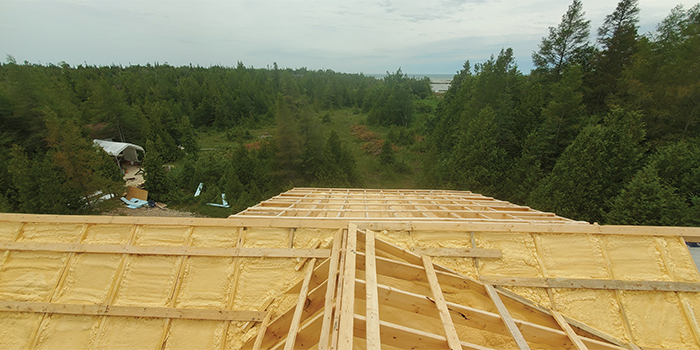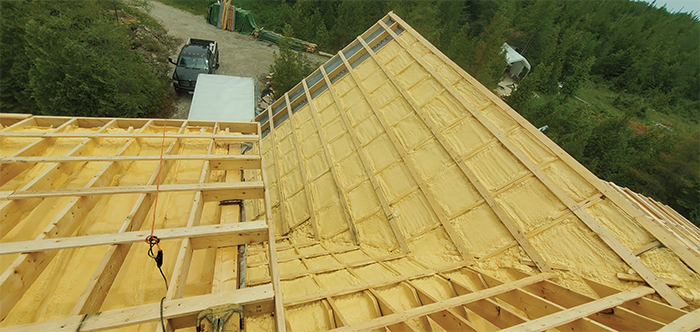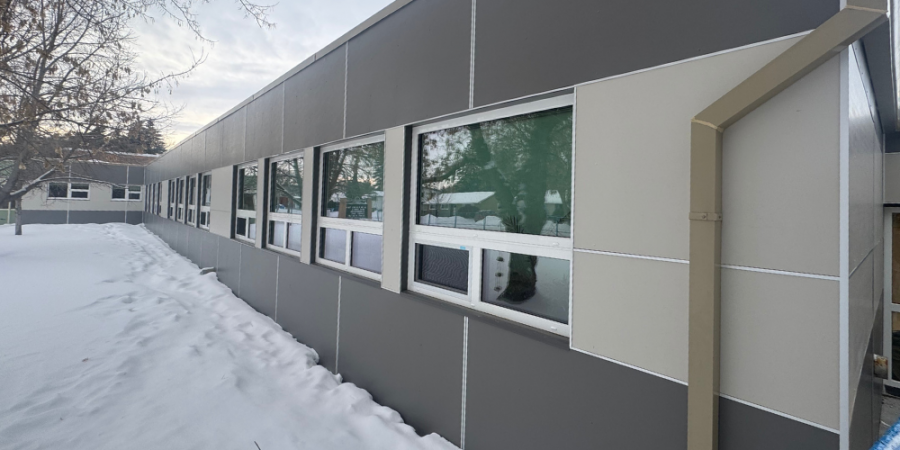Gimme Shelter


SPRAY FOAM MAGAZINE – The inception of Bognor, Ontario’s Polaris Spray Foam & Insulation started as a casual discussion at a family Christmas gathering between cousins Devon Yule and Nathan Vascotto. Combined, the two have over 15 years of spray foam experience and decades of insulation experience. Nathan also owns Peninsula Plumbing, based in Wiarton, Ontario. After taking stock of their combined talents and industry knowledge, it was clear that the two should start a business together. Polaris opened for business in April 2019 and now has six dedicated employees and serves two counties.
According to Devon, business is really heating up. This is probably due to the cousin’s industry expertise and adeptness at finding creative solutions to clients’ unique issues. For example, how do you insulate the roof of a log cabin that doesn’t have flat ceilings? The answer is a six-inch layer of expertly-applied Grizzly Gold Spray foam.
The log cabin in question was built in 2021 in Tobermory, Ontario, a town near the banks of Lake Huron. The log cabin was a new building constructed by Five Star General Contracting, for homeowners with the ultimate goal of living off-grid. The cabin’s timber was shipped in from British Columbia, and it was fitted with solar panels to provide energy for a completely off-grid setup. But the homeowners wanted vaulted ceilings rather than the standard flat ceilings, which posed an issue when deciding how to best insulate the roof against heat and air loss.
“It’s more common now for people to try and get away from doing the traditional flat ceiling. Everyone wants a cathedral and vaulted ceilings,” says Devon, recalling the recent trends he’s observed in modern home builds. The Tobermory cabin’s roof could not be simply an aesthetic choice – it had to be functional and well-suited to sustainable off-grid living in a region of Ontario known for its brutal, snowy winters.
The log cabin’s location in Tobermory, Ontario is situated on the Bruce Peninsula between Lake Huron and the Georgian Bay. This area is known for having long winters featuring high winds and intense lake effect snow. Houses built in this area must be well insulated to maintain energy efficiency and prevent heat loss. A log cabin’s solid timber walls provide built-in insulation; however, log cabins are more susceptible to air loss than other residential dwellings, and this is doubly true for their roofs. Even the tiniest air leak could cost a homeowner thousands of dollars in annual energy costs. The Tobermory log cabin was built with efficiency and sustainability in mind, and haphazard insulation was not an option.

Six inches of Grizzly Gold was sprayed on rooftop of the log cabin to reinforce the timber roof’s natural insulating qualities, while also shoring up any potential air leaks.
Energy efficiency is a crucial factor when designing a house for off-grid living, and vaulted ceilings don’t have room for attics, vents, or insulation against the roof. This means the cabin’s roof was the perfect candidate to receive a thick layer of spray foam insulation. In August 2021, Five Star hired Polaris to install SPF in the cabin’s roof and crawlspace in an effort to enhance the overall energy efficiency of the home and fortify it against rough Ontario weather.
“The weather here changes a lot, and it is very windy,” explains Devon. “Using spray foam just makes everything in the roof system way more rigid and stable.”
The interior walls of the cabin consist of timber, then a TYPAR weather-resistant membrane, then drywall. In comparison, the roof system’s layers are composed of timber, then spray foam, with a steel roof on top. Using spray foam in the crawlspace prevents cold air from the ground penetrating the floors, and using spray foam on the roof prevents warm air from rising up and escaping out of miniscule gaps in the vaulted ceiling. The foaming process is cost-effective in the long run, and it adds minimal time to roofing projects.
With the help of just one employee, Devon completed spray foaming the Tobermory cabin roof over the course of one windy week in August. The first step in the process involved dropping tarps down along the base of the cabin, which proved difficult given the relentless high winds. After securing the tarps as best as possible, they then applied Grizzly Gold 14133-l to the topside of the roof. To apply the foam, they used a PMC PH-25 machine with 210 feet of hose wrapped in a sidewinder protective cover.
They applied three separate layers of two-inch passes across the roof for a total of six inches of spray foam. Grizzly Gold closed-cell spray foam has an R-value of R-6 per inch. For context, the R-value of a standard softwood wall is about R-8. The spray foam reinforces the timber roof’s natural insulating qualities, while also shoring up any potential air leaks, rendering the log cabin completely sealed. After the foam dried, the Five Star General Contracting crew finished up the roof by adding the final steel top layer, and then the cabin was truly insulated from the top down.
Polaris Spray Foam completes projects of this nature on a regular basis, but manning sprayers high up on a rooftop in gusts of wind was no easy feat. They wore a safety harness, in addition to the standard PPE, to ensure the wind didn’t knock them off the roof. The job allowed them to show off their precision skills as they masterfully layered the foam despite the wind’s best attempts to blow the overspray onto the timber exterior walls. All in all, both the contractors and the homeowners were pleased with the final result, and the cabin was ready to withstand the test of time and the elements.
For use by SprayFoamMagazine.com & Spray Foam Magazine
Disqus website name not provided.









































